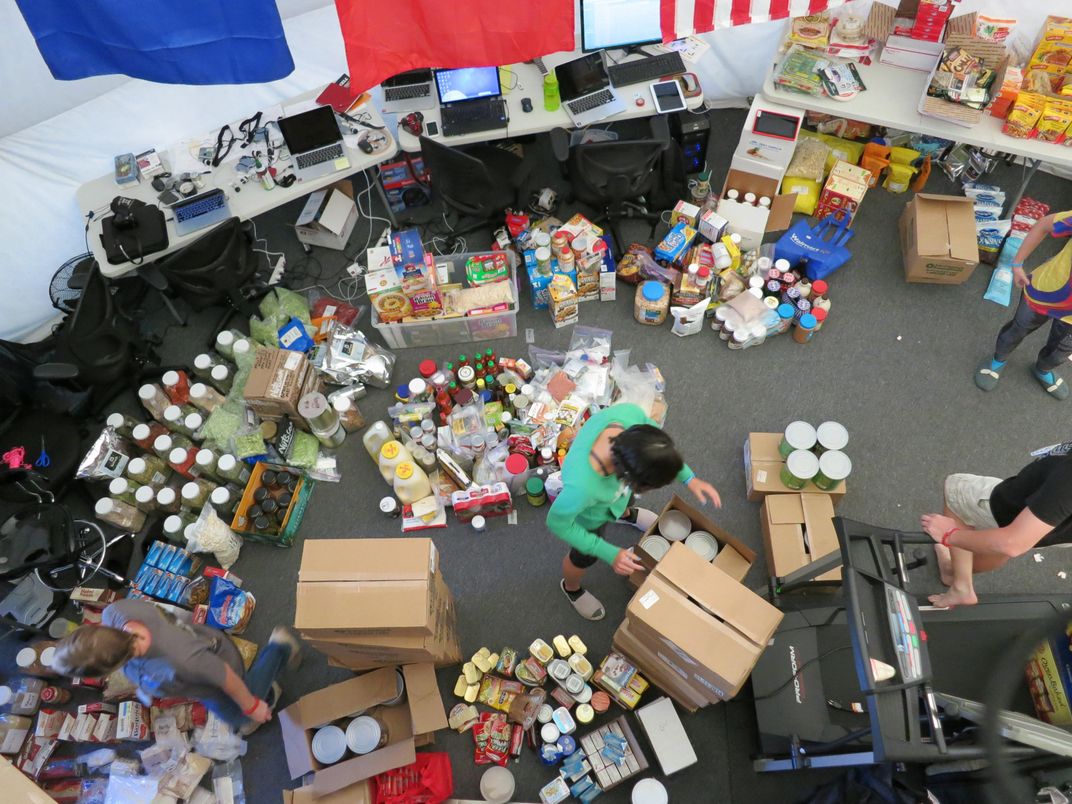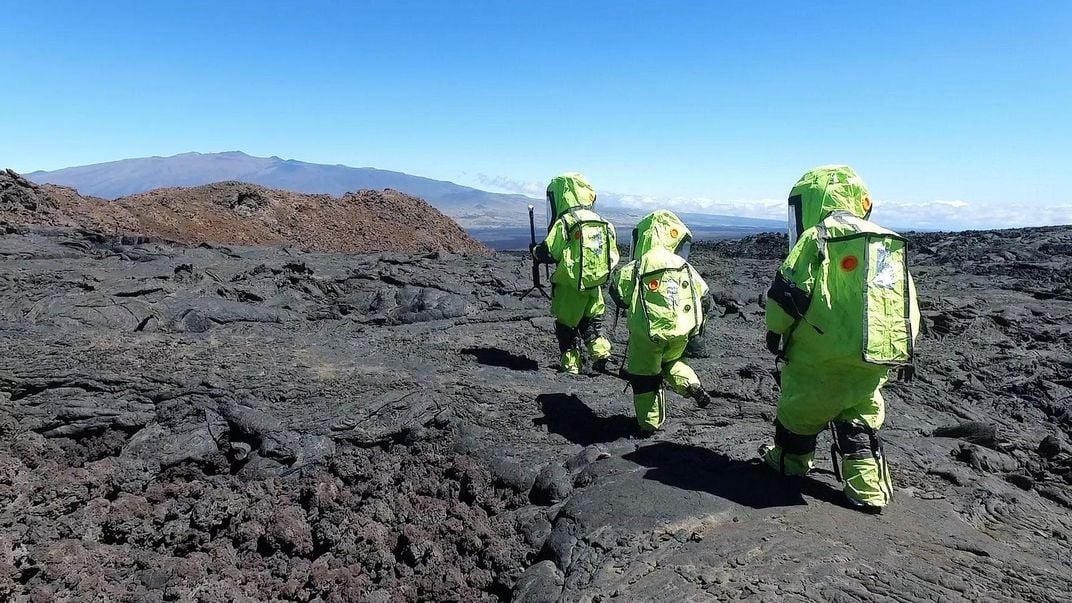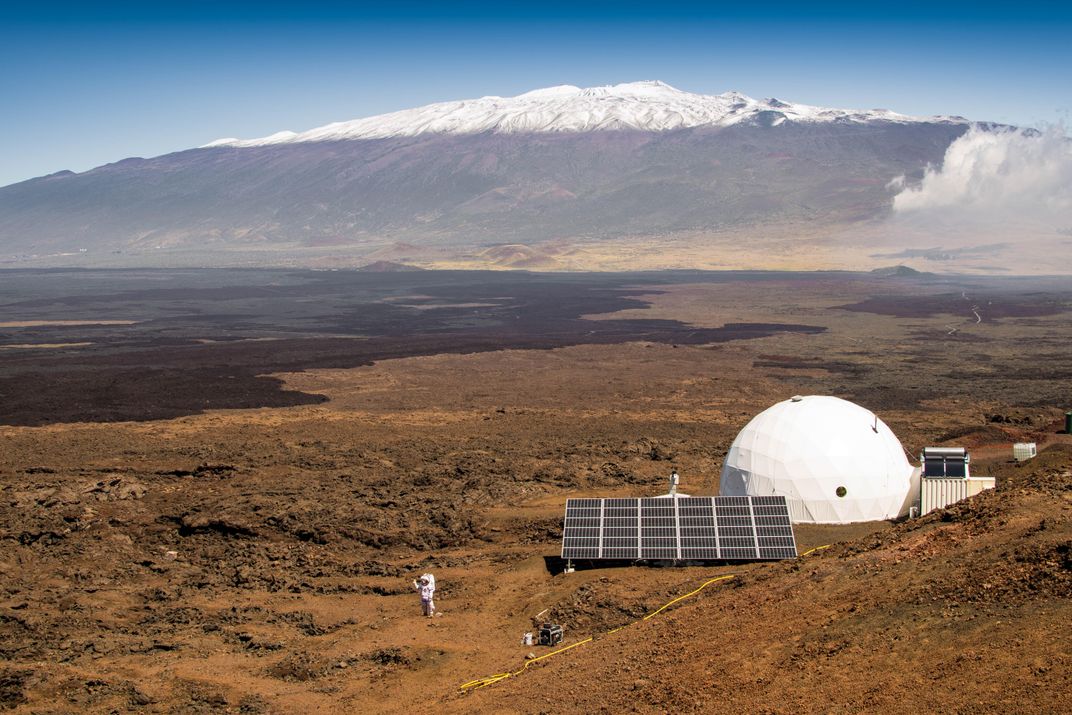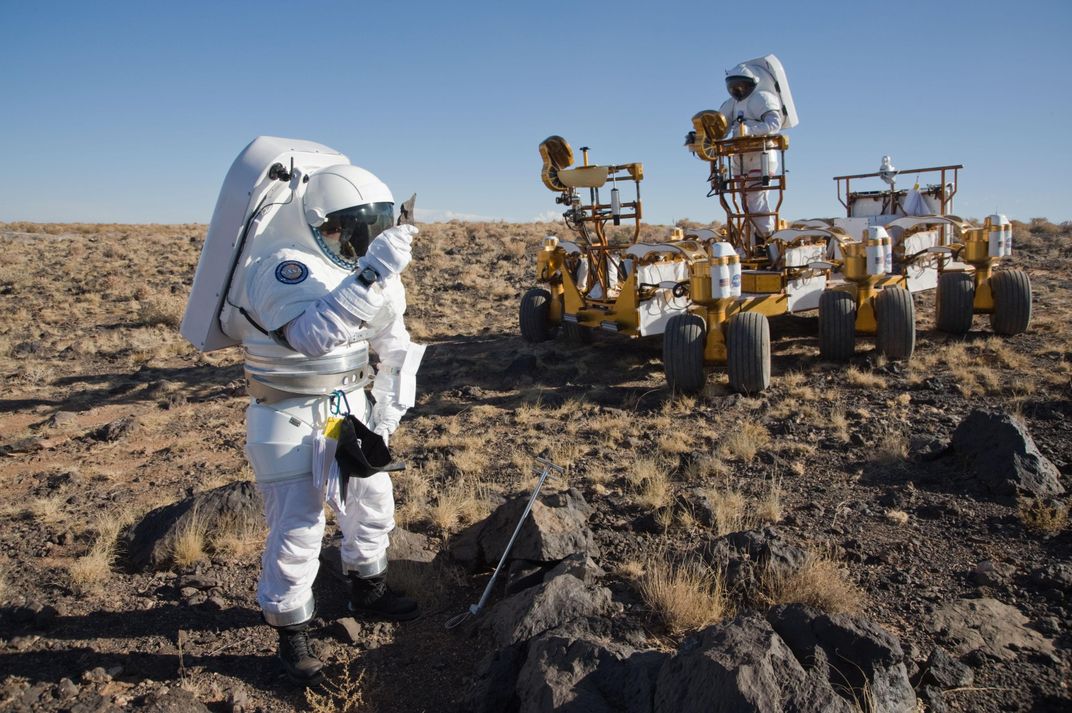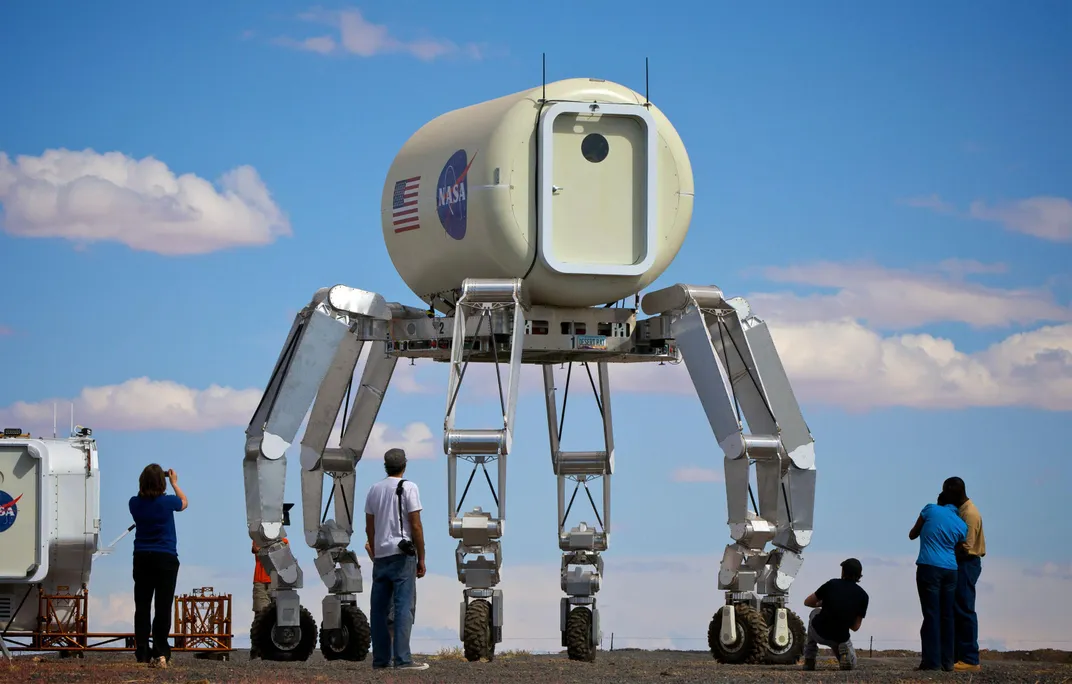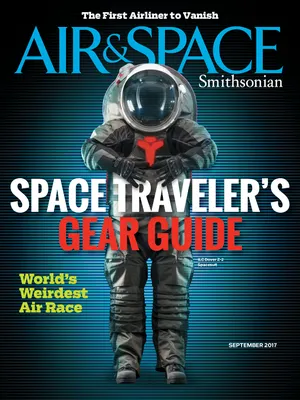Mars Fakers
Can we learn anything by pretending?
/https://tf-cmsv2-smithsonianmag-media.s3.amazonaws.com/filer/50/a0/50a0e9a0-0050-4255-8c78-9a4ddeea4caf/05g_sep2017_mdrs4_live.jpg)
“This is as close to flying an actual space mission as you can probably get without being an astronaut,” says Ron Franco, an American Airlines pilot and a retired U.S. Air Force colonel. In 2016, he volunteered for NASA’s Human Exploration Research Analog as part of a four-person, 30-day, simulated mission to the asteroid Geographos. HERA, which operates in a hangar at the Johnson Space Center in Houston, goes to great lengths to make the mission as realistic as possible; the project’s goal is to research what humans will need to handle long-duration space exploration. The experience, according to Franco, was deeply immersive.
“Although the main event was a rendezvous with Geographos,” he says, “the entire mission leading up to that rendezvous was very realistic training. We trained for EVAs [extra-vehicular activities] almost every day. When we actually rendezvoused with the asteroid, that was the highlight for the entire team. For me, it felt a little bit like the lunar module landing on the moon.” Throughout the mission, the crew dealt with the same inconveniences that astronauts on such a mission will have: infrequent showers, freeze-dried food, and a five-minute lag in communications with mission control that simulated the distance to Geographos, which orbits the sun three million miles from Earth.
Lauren Landon, a psychologist who oversees teamwork studies at HERA, says the crew runs scenarios as similar as possible to real-life missions. “People think that the volunteers are going in there and kind of playacting. Really, we give them the same sort of tasks that they’re doing on the space station. On the space station, for example, you have a robotic arm trainer, so we have a robotic arm trainer on our analog. You’re also not just playing at living together; you’re actually living together. All the stressors that come with being roommates are present.”
That desire for verisimilitude also applies to the selection of volunteers, because through the analog mission, NASA psychologists are trying to answer a specific set of questions about how to select, train, and manage astronauts for missions to an asteroid, the moon, or Mars. Real astronauts are too busy and their time too valuable to lock them away in a vault for a month for a mission that doesn’t actually exist yet. So the analog team looks for people like Franco, a pilot with a military background—the kind of person who might make it through a real NASA astronaut selection. “Many astronauts are engineers or medical doctors, so we’re looking for those backgrounds or skill sets,” says Landon. “We also want to get people of a certain age. We don’t want them to be young and fresh out of college, because they haven’t had the life experience or professional achievement yet. Astronauts come to us when they’re already successful in their career.” They’re looking for people who are resilient. “If we don’t have people who look and feel like astronauts going through these analogs, our data is not going to be worth generalizing out to later astronaut development.” There are other simulations that run much longer than HERA, and by comparing the data, you can start to see which variables can be accurately studied during a shorter simulation using fewer resources, says Landon. (Some factors, like team dynamics, can only truly be studied over a real-time mission, she says.)
One of the experiments the HERA crew participated in, run by Namni Goel of the University of Pennsylvania, looked at how sleep loss affects astronauts, a key issue for long-duration spaceflight, during which small, highly stressed crews may frequently be sleep-deprived. The experiment, conducted for two years over several HERA missions, involves having the crew members repeatedly test themselves for stress indicators, using everything from blood samples to questionnaires, to create a profile over time. She hopes that her data can help predict, before they go on a mission, how astronauts will react to sleep deprivation once in space, and give them the tools to deal with that stress.
In the Pacific, a newer group runs the Hawaii Space Exploration Analog and Simulation, or HI-SEAS, a NASA-funded, University of Hawaii-operated facility nestled in the lava fields on the slopes of Mauna Loa. At HI-SEAS, the pseudo-astronauts go on a simulated mission to Mars. One thing that sets this mission apart is the setting—its rugged, remote location enables crew members to simulate EVAs on a Martian-like landscape. And while HERA missions now last 45 days (up from the 30-day mission that Ron Franco volunteered for), last year HI-SEAS completed its first one-year mission.
Carmel Johnston is a soil scientist from Montana who served as crew commander for the 2016 mission. “The best part was getting to do a lot of the same research tasks that astronauts will be doing on Mars,” he says. “Mission control would say ‘We need you to find out more about this’ or ‘Find out if this is a safe place, or should we be exploring another region,’ just like they’ll be doing on Mars. Getting to wear the spacesuits outside and explore lava tubes on this barren landscape—it was all so new to us and so exciting every time we went outside.” They practiced the habits required for extended-duration space travel, like water rationing. “We would wash three weeks of clothes with one gallon of water,” says Johnston. The mission also mimicked the real 40-minute total delay in sending a message to mission control and waiting for a response.
HI-SEAS takes an additional step to make sure the volunteers are as astronaut-like as possible, says Kim Binsted, the University of Hawaii professor and principal investigator of the program. “As part of the application process, we ask them to propose a research project for themselves,” she says. “We find that if all crew members are doing are the psychological tests for the main NASA-funded research, they’re unstimulated in an unrealistic way. We want them to be doing serious research that could result in publications. That gives them meaningful work to do during the day, just like an astronaut.”
Some recent research done at HI-SEAS includes an experiment by Steve Kozlowski, a psychologist at Michigan State University, that tested a wearable electronic device that offered real-time feedback of team dynamics by monitoring crew members’ proximity to one another and the intensity of their interactions. Peggy Wu, a scientist for tech consulting company SIFT, is working on a program that analyzes the crew’s word use and grammar to get a sense of their mental states. And Raphael Rose, a clinical psychologist at the University of California at Los Angeles, is working with the National Space Biomedical Research Institute to develop software that will help crew members treat their own psychological conditions like depression, anxiety, or stress.
Several simulated Mars missions are run by foundations unaffiliated with NASA, perhaps not surprising given that space exploration is becoming more privatized. Two of the best known projects, the Mars Desert Research Station in southern Utah and the Flashline Mars Research Station on Devon Island in the Canadian Arctic, are managed by the Mars Society, a private organization that advocates for the human exploration of Mars. Because the society gets only meager agency funding, some critics say these simulated missions are less authentic than projects like HERA and HI-SEAS. But according to society founder Robert Zubrin, the two analogs benefit from longer experience. The Mars Desert project in Utah has been in nearly continuous (if sometimes impoverished) operation since 1998. Flashline has been running since 2000. And since these analogs conduct shorter missions—usually just two weeks—they’ve been able to run more than 170 simulated Mars missions with more than 1,000 participants. Those numbers allow them to thoroughly explore diversity. “We’ve had all-American crews, all-Russian crews, mixed international crews,” says Zubrin. “We’ve had all-man crews, all-women crews, mixed crews in every proportion, with different age distributions, different skill distributions, different character types.”
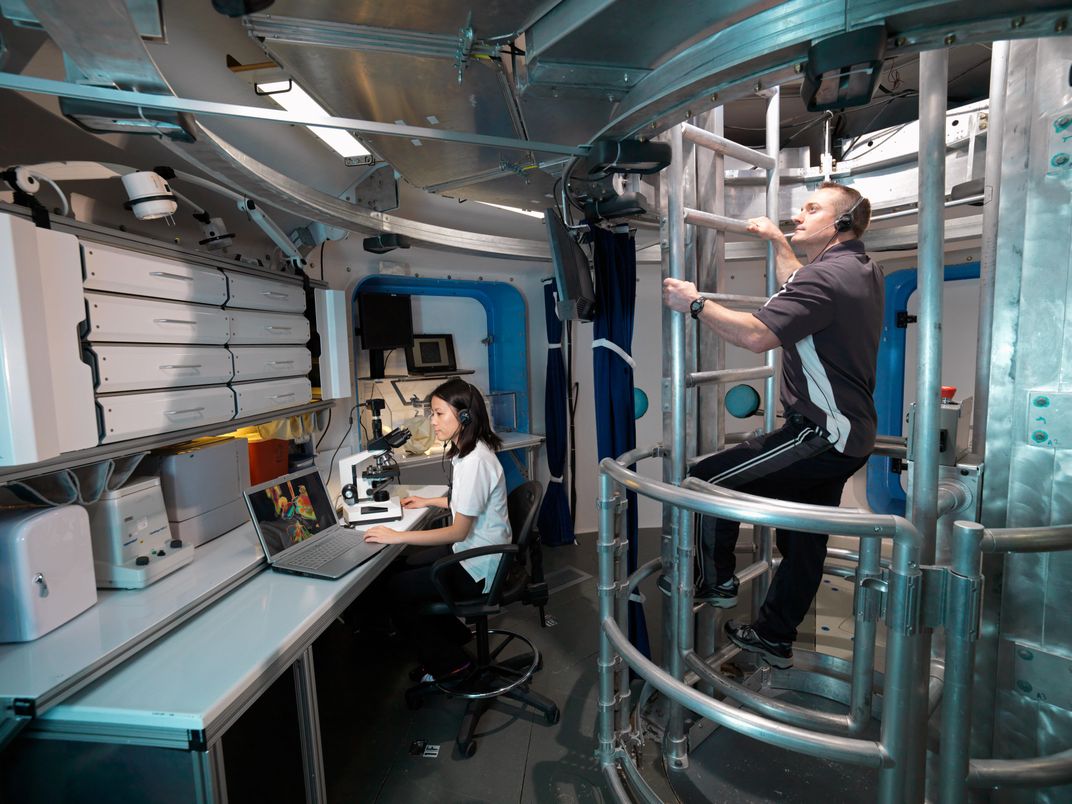
That’s a lot of data that has been analyzed and published—and it’s given Zubrin some strong opinions on what a future Mars mission needs. Foremost among them is that it would be a big mistake for astronauts to make the long voyage to Mars in a spacecraft without artificial gravity. That’s because the exploration that they’ll do once they get there isn’t going to be just lab work; it’s going to involve hard, physical labor. Spending six months in zero gravity will leave the astronauts physically weakened. “That’s not the right way to go to Mars,” says Zubrin. “And yet, the entire space medicine program…is about researching the health effects of zero gravity. They’re spending billions of dollars researching the wrong problem. They should be looking into artificial gravity, which you can create by simply rotating the spacecraft.” Regardless of whether NASA is heeding any of the recommendations coming out of the Mars Society simulations, it’s worth noting that several of the staff and volunteers on taxpayer-funded missions got their start at either Mars Desert or Flashline.
The earliest human spaceflight simulations were more interested in answering engineering and operational questions. NASA famously carted the Apollo astronauts to a variety of moon-like places—Arizona’s Meteor Crater and California’s Mojave desert among them—to check out equipment and rehearse some of the procedures the astronauts would use on lunar landings. The modern iteration of these simulations took place at NASA’s Desert Research and Technology Studies, a recurring expedition to lava fields and deserts, usually near Flagstaff, Arizona. The brainchild of Joe Kosmo, a spacesuit expert who has worked on every NASA human spaceflight program going back to Mercury, Desert RATS started out as a way to test spacesuit technology in terrains that were similar to the moon or Mars.
Dean Eppler, who retired from NASA last year, was Kosmo’s protégé and a founding member of Desert RATS. A geologist by training, he served on the simulation’s first crew, helping refine the design and working protocols for 200-pound spacesuits so future astronauts could wear them to do fieldwork on Mars, the moon, or an asteroid. After several years, he rose to manager of science operations and helped oversee the dramatic expansion of the program.
“In 1998, when we did our first test, there were only seven of us: myself, Joe, a communications tech, and four suit techs,” Eppler says. “We also had a photographer come along, and we had a safety tech who thought we were crazy. By the time we did the last Desert RATS in the field in Arizona, there were so many people we had to have ID badges.”
As the staff expanded, so did their portfolio of research, from suit testing to ground equipment and even to rovers. “The culmination was in 2010,” says Eppler, “when we essentially did a full-up, long-duration, four-crew, two-rover lunar surface mission. We had a lunar habitat, and we simulated what it would be like to have two sets of two crew members in pressurized rovers on an extended geological traverse around an area. They weren’t using pressure garments, but they wore backpacks with communications systems and a lot of navigation stuff. By that time, Desert RATS was more about the rover and the ability to manage the operations.”
This kind of simulation is qualitatively different from HERA or HI-SEAS. When the subjects of study are humans, that research is, for the most part, debated and validated in peer-reviewed journals. But for the kind of research done at Desert RATS, the proof is in the pudding. Either the equipment and procedures developed work, or they don’t. Either the rover has enough traction to drive over the mock lunar landscape, or it doesn’t.
And yet, for all its success, the Desert RATS haven’t made the expedition to the Arizona desert for six years. Part of the reason is the sheer scale of the operation—it took most of the year to set up and analyze results, and then they had to start all over again—but it had also started reaching a point of diminishing returns, because the factors that still needed to be studied were getting prohibitively expensive or technically impossible to simulate in the field, like the microgravity on an asteroid. In 2012, the simulation was done almost completely through a virtual reality rig set up at Johnson Space Center, and they haven’t returned to the desert since.
Back in the moon-like landscape of Hawaii, another simulation, run by the Pacific International Space Center for Exploration Studies, or PISCES, focuses on “in situ resource utilization”—researching the skills and technology required to use only what’s available in the environment to survive. It’s a key area of research if people are ever going to colonize Mars or the moon. Robert Kelso, the former director of PISCES, says, “When we did Apollo, back in the late 1960s and early 1970s, we brought everything we needed with us, and left everything there when we came back. The whole concept of going to the moon or Mars for settlement is completely different. It’s minimizing what you take, because everything you take is extremely expensive to launch into orbit.” One of the most important resources to study is water, says Kelso. Water exists on Mars and the moon as both ground ice and in more complex hydrogen-oxygen molecules. If astronauts can collect and distill it, that water can be used not only for drinking but also for breaking into constituents, which would power fuel cells and rockets.
PISCES, however, was focused on a very specific question: Was it possible to use robots to turn the powdery basaltic material on the lunar surface into a solid landing pad? “The Apollo guys talked about this,” says Kelso. “If there’s anything in the line of sight—antennas, solar arrays, habitats, lunar cars, anything—it could just get obliterated by this mega-sandblaster.” The PISCES group succeeded in using a commercial kiln to melt the local rock into bricks that were stronger than concrete. Using robotic rovers, they arranged the bricks into a landing pad and compressed the surrounding surface with larger stones to contain flying debris.
Important as they are, NASA’s living-off-the-land simulations are, for the most part, no longer active. Robert Mueller, who oversees these kinds of engineering projects for NASA, says they suffered pretty much the same fate as Desert RATS. “Management didn’t like the cost of it, so we moved it into the lab. Swamp Works, my lab at Johnson Space Center, has an indoor, simulated-surface, planetary test bed. We test there, for now.” But Mueller still advocates for the kind of testing that can be done only at a remote location. “In the lab, we tackle the known unknowns, but when you go to the field, you have integration issues that you never ran into in the lab,” he says. “Field testing always has an element of unpredictability to it.”
Mueller cites the Haughton-Mars Project, which, like the Flashline Mars Research Station, is on Devon Island in the Canadian Arctic. Devon is the largest uninhabited island in the world, a bitter landscape even during the height of summer. Scientists like Chris McKay of NASA’s Ames Research Center, a prominent researcher on the biology of extreme environments, used the island’s cold, dry climate to investigate what life on Mars might look like.
But it was Pascal Lee, one of McKay’s post-doc students, who saw the opportunity that Devon Island presented as a location to study how humans might go exploring on Mars, and began running the Haughton-Mars Project there in 1997. In addition to the barren, rocky landscape and the water locked up in ground ice, it contains a 12-mile-wide crater made from a meteorite impact 23 million years ago (by comparison, Arizona’s Meteor Crater is only two-thirds of a mile across). “What was immediately apparent to me was that Devon Island was an incredible place to learn how to explore,” says Lee. NASA agreed, and has sent analog missions there every summer for the past 20 years. Because of that, many of the other Mars analogs that exist today have Lee to thank. Says McKay, “Virtually everyone that’s now doing human factors and robot research in Mars base simulations was involved with [Haughton-Mars Project] and Pascal at some point.... He really added a whole new dimension to this activity.”
The Haughton simulation also demonstrates Rob Mueller’s premise that analogs help identify “unknown unknowns.” The danger inherent in the Arctic environment adds a level of realism that’s often absent from other analogs. He describes a four-day drive to deliver a vehicle to the expedition on Devon Island. “There are no roads there, and we were simulating a mission where mission control was texting directions to me, and I was the navigator and had to follow their directions. The problem was that they were using orbital maps, and I was on the ground, and many times the resolution of the orbital data wasn’t high-fidelity enough to make their directions useful. At one point, they said ‘Go to Point B,’ and I texted back ‘Well, I’d like to go to Point B, but there’s a canyon in the way.’ ”
Pascal Lee says less dangerous analogs, like HI-SEAS and HERA, are unrealistic. “Crew psychology studies without the crew facing real danger and actual safety issues are meaningless. First of all, the behavior of small crews in confined, isolated, and remote environments is something that we already have a huge amount of experience in. NASA has flown many long-duration small crew missions.... The military has a huge amount of experience with special ops and submarines. Not to mention the whole body of experience with mountaineering expeditions, with seafaring and polar exploration. And one of the things that we’ve learned from all these experiences is that you can’t learn much about how a crew works or breaks down unless it is truly isolated, remote, and/or faces real life-and-death situations. That’s where the real tension in the crew arises. I’ve led or been part of more than 30 polar expeditions, and I can tell you that, unless you experience real danger, that crew experience means nothing.”
/https://tf-cmsv2-smithsonianmag-media.s3.amazonaws.com/filer/0c/ab/0cab56f6-85ed-4841-b351-6716f7dd27c7/05n_sep2017_haughtonmarsfinalmicrosize_live.jpg)
Lee is similarly dismissive of Russia’s Mars-500 project, a simulation in which six volunteers were isolated in a mock habitat for almost a year and a half, about the duration of a real mission to Mars. But these volunteers didn’t face any real danger during their confinement. “Any crew can pretty much work out its problems under those circumstances, as long as you don’t talk religion or politics,” says Lee. Robert Zubrin of the Mars Society agrees that volunteers sitting around “playing chess” isn’t a very convincing simulation for astronauts on a dangerous mission to Mars. He also points out that with simulations that go on for years, it’s difficult to have multiple iterations, making it hard to draw meaningful conclusions.
Nevertheless, it’s clear that to do human behavioral research for long-duration space exploration, there are some things you can find out only by using long-duration simulations. That’s why HI-SEAS, HERA, and even the Mars Society have gradually extended the duration of their own simulations. In fact, both HERA and HI-SEAS plan to collaborate with the Mars-500 facility in the future.
Some astronauts—real ones—are doubtful about the usefulness of any of these projects, no matter how hard the analogs try to get appropriate candidates to volunteer. Pam Melroy, who served as a pilot on two space shuttle missions and commanded Discovery on a mission to the International Space Station in 2007, isn’t sure volunteers can match the drive and commitment of actual astronauts. “Astronauts are Ph.D.s, medical doctors, test pilots, and successful engineers,” she says. “Typically, there’s a fair amount of drive involved in that personality type. The question that I have is: If you’re a driven person, why would you participate in this program?”
But the most damaging criticism of the simulations comes from within the community itself in answer to the essential question: Are these projects going to enhance our ability to do long-duration space exploration? Even the Haughton-Mars Project, the most venerable analog, doesn’t escape scrutiny in this regard. Dean Eppler, the veteran of more than a dozen Desert RATS expeditions, says that Haughton may not generate enough scientific information to be worth the investment. “When we finished Desert RATS 2010,” he says, “we realized that we had done so much, and that it was such a complex and critical test, that we convinced the journal Acta Astronomica to allow us to publish a special issue. We had 14 papers…. We wanted to do that because we wanted to get that data out in the literature where anybody could find it. But Devon Island never had that ethic. I’m still not sure what we learned from Devon Island, because they went up there and nobody ever wrote any reports.” (Rob Mueller disputes this and points out, for example, there are Haughton-Mars rock samples in his lab and they will be publishing a paper on them soon.)
The debate on the usefulness of the simulations will continue until someone with a rocket decides to prove it by sending astronauts to set up house on another planetary body. Then we’ll find out if these Earthbound missions have made long-distance exploration easier for the future first settlers, or if the real experience was always going to be too far outside our imaginations to simulate.
